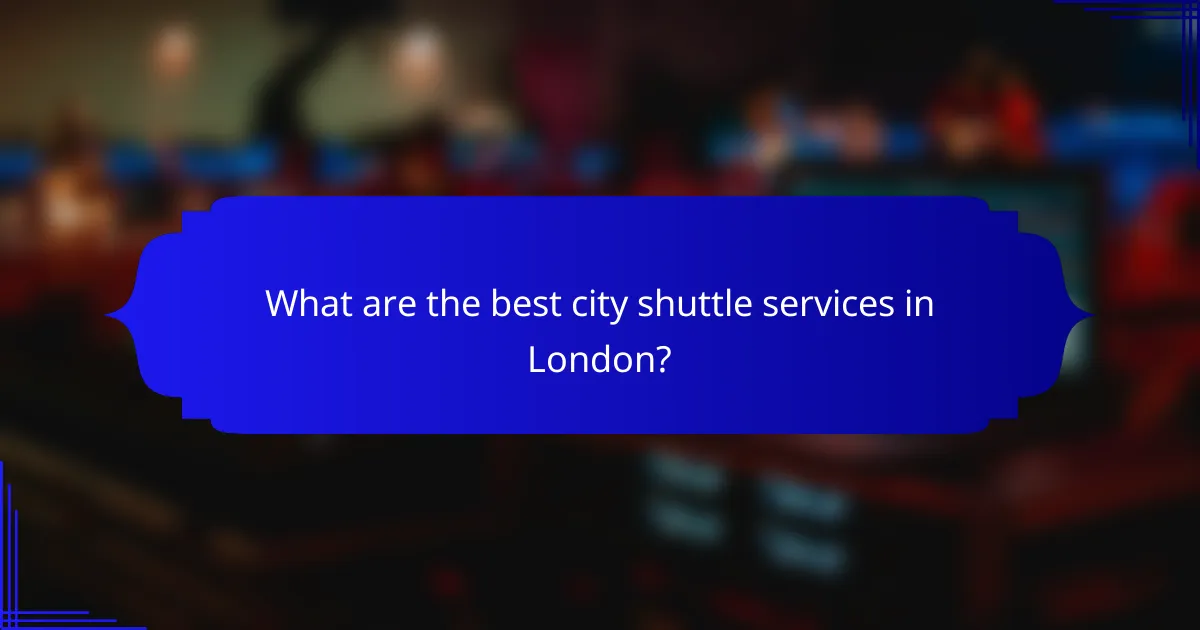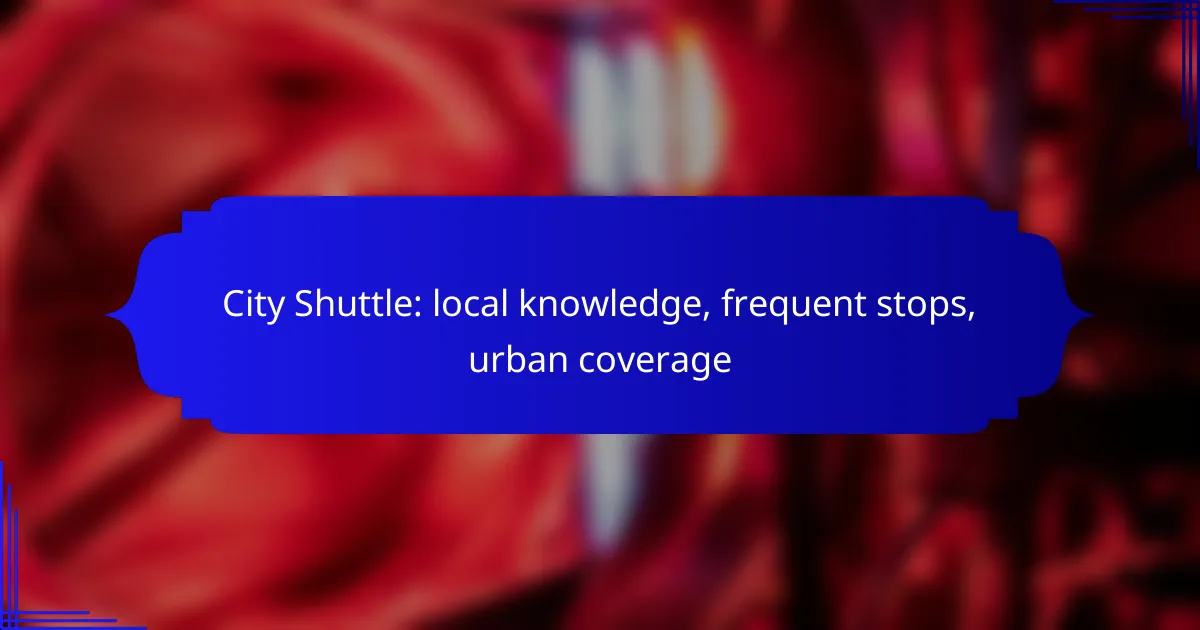City shuttles are an essential part of urban transportation, offering efficient and reliable services with frequent stops across the city. They cater to both locals and tourists, ensuring easy access to key destinations while promoting public transport use and reducing traffic congestion. With their affordability and convenience, city shuttles enhance mobility and make navigating urban environments simpler for everyone.

What are the best city shuttle services in London?
The best city shuttle services in London provide efficient, reliable transportation with frequent stops throughout the urban area. These services cater to various needs, from local commuters to tourists, ensuring easy access to key destinations.
Greenwich Shuttle
The Greenwich Shuttle is a convenient service that connects various locations within the Greenwich area. It operates frequently, making it ideal for both residents and visitors looking to explore attractions like the Cutty Sark and the Royal Observatory.
This shuttle typically runs every 10-15 minutes, allowing passengers to hop on and off easily. Consider using this service for short trips, as it covers major points of interest without the hassle of parking.
Citymapper Shuttle
The Citymapper Shuttle is a tech-driven service that integrates with the Citymapper app, offering real-time updates and route planning. It focuses on popular routes in central London, making it a favorite among commuters and tourists alike.
With a user-friendly interface, passengers can track shuttle locations and estimated arrival times. This service is particularly useful for navigating busy areas, as it helps avoid delays and ensures a smooth travel experience.
Uber Shuttle
The Uber Shuttle service provides a flexible option for those looking for on-demand transportation in London. It allows users to book rides through the Uber app, making it convenient for spontaneous travel needs.
While it may be slightly more expensive than traditional shuttles, the convenience of door-to-door service can justify the cost. Be mindful of surge pricing during peak hours, which can significantly increase fares.

How do city shuttles enhance urban mobility?
City shuttles improve urban mobility by providing efficient, reliable transportation options that connect various parts of a city. They help reduce traffic congestion and promote the use of public transport, making it easier for residents and visitors to navigate urban environments.
Frequent stops
City shuttles typically feature frequent stops, allowing passengers to board and disembark at convenient locations throughout the city. This design minimizes walking distances and encourages more people to use public transport. For example, shuttles may stop every few blocks, making it easy for commuters to access workplaces, schools, and shopping areas.
In many cities, shuttle routes are strategically planned to cover high-density areas and popular destinations. This ensures that riders can quickly reach their desired locations without long wait times. Frequent stops can significantly enhance the overall user experience and increase ridership.
Accessibility for all
City shuttles are designed to be accessible for all users, including those with disabilities. Many shuttles are equipped with features such as low floors, ramps, and designated seating to accommodate passengers with mobility challenges. This commitment to accessibility ensures that everyone can benefit from urban transportation options.
In addition to physical accessibility, shuttles often provide real-time information through apps or displays, helping all riders plan their journeys effectively. Cities may also implement policies to ensure that shuttle services are compliant with local accessibility regulations, further enhancing inclusivity in urban mobility.

What are the benefits of using city shuttles?
City shuttles offer numerous advantages, including affordability, convenience, and reduced environmental impact. They provide a reliable means of transportation that connects various urban areas, making it easier for residents and visitors to navigate the city.
Cost-effective transportation
City shuttles are often more affordable than traditional taxi services or rideshares, making them an economical choice for daily commuting. Many shuttles charge a flat fare or offer monthly passes, which can significantly reduce transportation costs for frequent users.
For example, a typical shuttle fare may range from $1 to $3 per ride, while monthly passes can be available for around $30 to $100, depending on the city. This pricing structure makes shuttles an attractive option for budget-conscious travelers.
Reduced traffic congestion
Using city shuttles helps alleviate traffic congestion by decreasing the number of individual vehicles on the road. When more people opt for shuttles, it results in fewer cars, leading to smoother traffic flow and reduced travel times for everyone.
In urban areas, a single shuttle can replace multiple cars, which not only eases congestion but also lowers emissions. Cities that promote shuttle services often see a noticeable improvement in air quality and a decrease in noise pollution, benefiting both residents and the environment.

How to choose the right city shuttle service?
Choosing the right city shuttle service involves evaluating its coverage area, frequency of stops, and customer reviews. These factors will help you determine which service best meets your travel needs and preferences.
Service coverage area
The service coverage area refers to the geographical regions that the shuttle operates within. Look for a shuttle service that connects key locations such as airports, business districts, and popular tourist attractions to ensure convenience.
Some shuttles may only cover specific neighborhoods or routes, while others offer extensive urban coverage. Check the service map on the shuttle’s website to confirm that it aligns with your travel plans.
Frequency of stops
Frequency of stops indicates how often the shuttle picks up and drops off passengers along its route. A higher frequency means shorter wait times, which can significantly enhance your travel experience.
Many city shuttles operate on a schedule, with intervals ranging from every 10 to 30 minutes. Consider your timing needs and choose a service that offers a frequency that suits your travel schedule.
Customer reviews
Customer reviews provide insights into the reliability and quality of a city shuttle service. Look for feedback regarding punctuality, cleanliness, and overall customer satisfaction to gauge the service’s reputation.
Websites and apps that aggregate reviews can be helpful. Pay attention to consistent themes in the feedback, as these can indicate strengths or weaknesses of the service you are considering.

What are the common features of city shuttles?
City shuttles typically offer convenient transportation options with frequent stops and extensive urban coverage. They are designed to facilitate easy access to key locations within a city, making them a popular choice for commuters and visitors alike.
Real-time tracking
Real-time tracking is a crucial feature of city shuttles, allowing passengers to monitor the location and arrival times of their shuttle. Many services provide mobile apps or websites where users can view live updates, reducing wait times and enhancing the overall travel experience.
When choosing a city shuttle, consider those that offer reliable tracking systems. This feature can significantly improve your planning, as it helps you avoid long waits and ensures you catch your shuttle on time.
Comfortable seating
Comfortable seating is another important aspect of city shuttles, as it directly impacts the passenger experience. Many shuttles are equipped with spacious seats, ample legroom, and sometimes even amenities like charging ports and Wi-Fi, making your journey more enjoyable.
When selecting a shuttle service, look for options that prioritize comfort. Check reviews or ask locals about their experiences to find shuttles that consistently provide a pleasant ride, especially during peak travel times when buses may be crowded.

What are the pricing models for city shuttles?
City shuttles typically offer various pricing models to accommodate different passenger needs. The most common options include flat rate pricing and subscription plans, each catering to specific usage patterns and preferences.
Flat rate pricing
Flat rate pricing is a straightforward model where passengers pay a fixed fee for a specific route or distance. This model is often ideal for occasional users who prefer simplicity and transparency in their travel costs.
For example, a flat fare might range from $2 to $5 for a single trip within a city, depending on the distance and local regulations. It’s essential to check if this fee includes any additional services, such as luggage handling or transfers.
Subscription options
Subscription options provide a cost-effective solution for frequent riders, allowing them to pay a monthly or annual fee for unlimited travel within certain parameters. This model is beneficial for commuters or regular users who want to save on individual trip costs.
Typically, subscription fees can range from $50 to $150 per month, depending on the service area and frequency of use. Users should evaluate their travel habits to determine if a subscription is financially advantageous compared to pay-per-ride pricing.

How do city shuttles compare to traditional public transport?
City shuttles offer a more flexible and responsive alternative to traditional public transport systems. While traditional buses and trains follow fixed routes and schedules, shuttles adapt to user demand, providing a tailored travel experience within urban areas.
Flexibility of routes
City shuttles have the advantage of flexible routes that can change based on real-time demand and passenger needs. Unlike traditional public transport, which adheres to set paths, shuttles can adjust their stops and destinations to better serve specific neighborhoods or events, enhancing accessibility.
This flexibility allows shuttles to fill gaps in public transport coverage, particularly in areas that may be underserved. For example, a shuttle might operate a route that connects residential areas to commercial centers, making it easier for residents to access jobs and services.
On-demand services
On-demand services are a hallmark of city shuttles, allowing passengers to request rides as needed rather than adhering to a fixed schedule. This service model is particularly beneficial in urban settings where travel needs can vary significantly throughout the day.
Many city shuttles utilize mobile apps for ride requests, enabling users to book a shuttle within minutes. This system not only reduces wait times but also allows for more efficient use of vehicles, as shuttles can be dispatched based on current demand rather than running empty on predetermined routes.
